
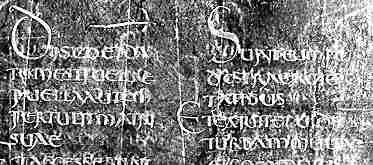
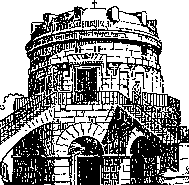
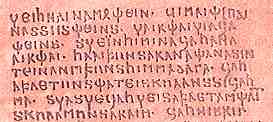
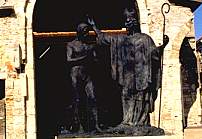
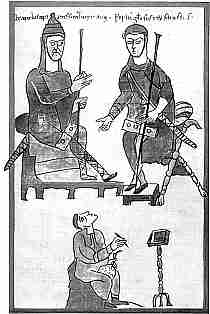
If you are looking at this page without frames, there is more information about medieval writing to be found by going to the home page (framed) or the site map (no frames).
| Vernacular Bibles | |||||
| The standard Bible of the middle ages was the Latin Vulgate version attributed to St Jerome. However, at various times Bibles, or paraphrases of Bible stories, appeared in the vernacular. These had a chequered history, and it seems that each florescence of the vernacular Bible was followed by a crackdown by the church authorities. The short explanation as to why, is that the church was autocratic and kept the sacred words under their own control as a means of combatting heresy. A closer look at the whole relationship between language, literacy and authority poses some interesting points to ponder. | |||||
 |
When Christianity became the official religion of the Roman Empire in the early 4th century, during the reign of Constantine, Latin was the vernacular of the ruling classes, not only in Italy, but way beyond. The imposition of authority over even the most nitpicking details of the beliefs of the Christian church was related to the imposition of authority by the emperor over his subjects. The divergences of belief among those who were to be labelled heretics were often highly esoteric and not related to the basics of living a good Christian life, nor to anything that could be clarified by a simple reading of the Bible. However, a squabbling church represented a squabbling empire, and that was not good. Conformity in belief represented good government. | ||||
| The Emperor Constantine | |||||
 |
|||||
| This is a small segment of a leaf from the Codex Palatinus (British Library, add. ms. 40107, f.1), an Old Latin version of the gospels from the 4th or 5th century. By permission of the British Library. | |||||
| There were various Latin versions of the Bible around in the early centuries. The long process by which St Jerome translated the Old Testament afresh from Hebrew versions, and the New Testament from Greek, was to render an accurate version of the text in the vernacular. The name Vulgate, by which his translation is known, simply refers to the fact that it is in the common tongue. However, over the period of several centuries when this version of the Bible became the standard text for the expansion of the Christian religion back into the territories of the pagan barbarian rulers, the language was no longer that of the people, but of an intellectual elite living in monastic seclusion. | |||||
 |
The Roman Empire did not end one Thursday, but while the early monks were attempting to spread their message across an ethnically labile and disordered Europe, central government and control were falling apart. By the early 6th century a barbarian, Theoderic, an Ostrogoth, had set himself up in Italy as emperor; not that there was much to be emperor of. | ||||
| Mausoleum of Theoderic at Ravenna. | |||||
 |
Segment from the Codex Argenteus in Uppsala, a 4th century Gothic language Bible text. | ||||
| A better image of a page from this manuscript can be found here on the Codex Argenteus website produced by Uppsala University Libraty. | |||||
| At this time some religious texts, including Biblical texts, were translated into the Gothic language and produced in lavish editions, with silver or gold ink on purple dyed vellum, a tradition for very posh manuscripts in the Byzantine culture. No doubt this use of the vernacular for sacred texts was putting a Gothic stamp on kingship and following an imperial tradition of tying together church and state. Theoderic did not found a dynasty. The emperor Justinian reclaimed some of the Western Empire, for a time, and Europe went reeling along its chaotic track. | |||||
| Very few of these Gothic language codices survive. They did not just fade away, but were actively destroyed by an authoritarian church which was developing its own power base in the world of temporal affairs. Relics have been discovered, scraped down and written over as palimpsests, among the books from libraries such as the monastery of Bobbio. The Goths were followers of the Arian heresy, and their texts were destroyed along with other heretical works from which the parchment was reclaimed in the early monastic expansions. | |||||
| What the Arians believed was not in defiance of Christian practice, but of philosophy and, dare one say, semantics. They held that, within the Holy Trinity, the Son was inferior to the Father. The Father was eternal, but the Son had an origin. The belief sprang from similar sources to those of the Gnostics, Greek speakers steeped in the subtle terminologies of philosophy. Complex concepts were possibly lost in translation. The dispute was aired vigorously at the First Council of Nicea in 325, attended by the Emperor Constantine himself. | |||||
 |
The Arian belief took hold among a number of the barbarian groups and the Catholic hierarchy took some centuries to get rid of it entirely. When the Frankish king Clovis was baptised with great fanfare, it is more than likely that he was being rescued, not from paganism, but from Arian Christianity, although that is not what it says in the chronicles. | ||||
| A modern stature of the baptism of Clovis, outside the church of St Remi in Rheims, where the event supposedly occurred. | |||||
| By the time of Charlemagne, the church in the barbarian kingdoms was restoring orthodoxy to the essential text by ensuring that libraries contained St Jerome's Vulgate text of the Bible. That ensured there could be no anomalies of interpretation. Besides, Charlemagne rather modelled himself after a Roman Emperor, so Latin rather than Frankish texts again helped to tie together church and concepts of kingship. It is also possible that the Frankish aristocracy actually spoke Latin as a second language, as their own vernacular was not that of many of their subjects. The great Bibles of the Carolingian era were all in Latin. |
 |
||||
| A 10th century miniature depicts Charlemagne giving counsel to his son Pepin, king of Italy, while a scribe records proceedings (Modena Cathedral Archives, Cod. ord. 1. 2., f.156). | |||||
|
|
|||||
|
If you are looking at this page without frames, there is more information about medieval writing to be found by going to the home page (framed) or the site map (no frames). |
|||||